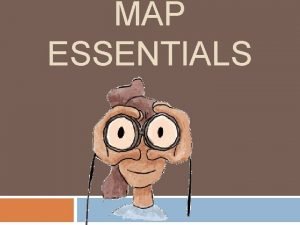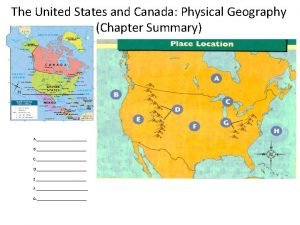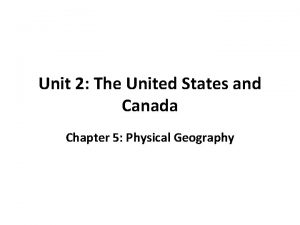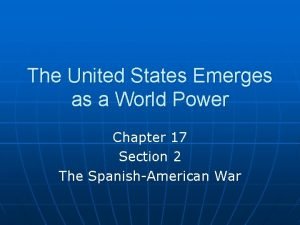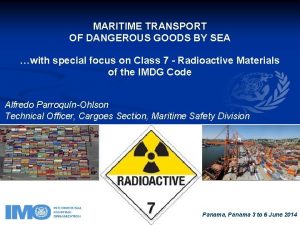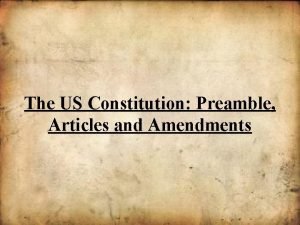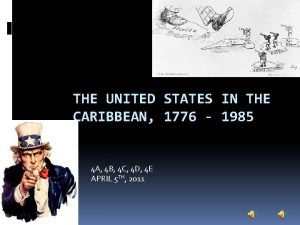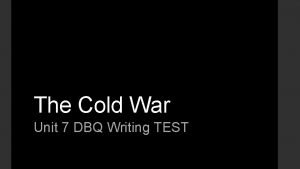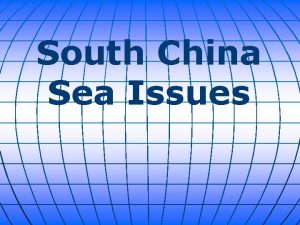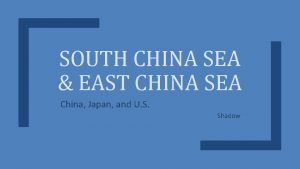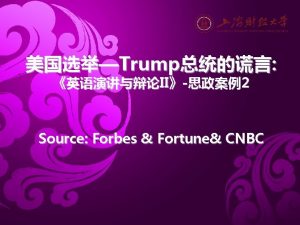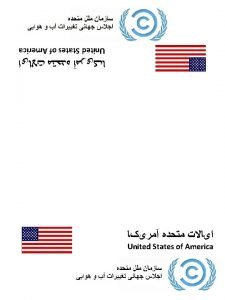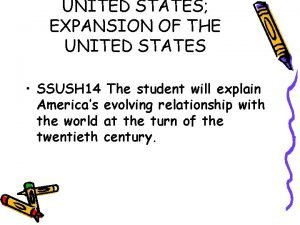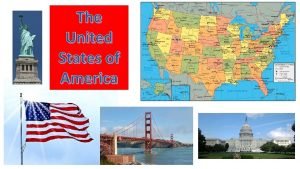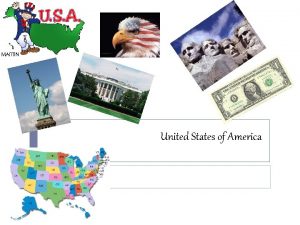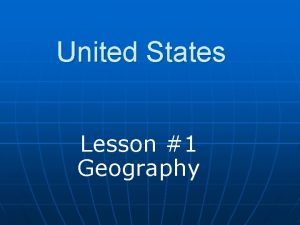South China Sea Conflict United States and China























- Slides: 23

South China Sea Conflict United States and China – Quo vadis? Ole Engelhardt & Jihoon Kim US-China Forum East Asia Institute 09 May 2016

Agenda • Introduction & Background Information • Status Quo Current U. S. Position Current Chinese Position Pointing out main obstacles • Short Introduction into Middle Power Politics – What can be the role of South Korea? • Summing Up: Chances & Outlook • Conclusion

What is the conflict about? ‘’We don’t take a position on the individual claims in the South China Sea[…] but we have an obligation to protect freedom of navigation’’ ‘’President Xi[…] said that China will not militarize the South China Sea. But there is increasing evidence that’s not the case. ’’ ‘’We have the advantage of not ourselves being claimants–of not havingso to speak a dog in the fight of who gets what. ’’ Background ‘’We want to see the disputes resolved peacefully, diplomatically [. . . ] but the US military has an obligation, a responsibility, to look after the security interests of the American people’’ “It is our stance that freedom of navigation and freedom of flight should be ensured in this area, and that any conflicts be resolved according to relevant agreements and established international norms. ” ‘’ China has indisputable sovereignty over islands in the South China Sea and their adjacent waters. ’’ ‘’The flexing of military muscles and creating of tension by the US under the pretext of the freedom of navigation is the biggest cause of militarization in the South China Sea. We advise the US to stop as soon as possible’’

What is the conflict about? • Where is it? The dispute involves two archipelagoes, Spratly and Paracel. There are 6 different countries around the body of water. • When did it start? • The conflict dates back to ancient times • The current debate over sovereignty however was approx. initiated in 1927 when Japan made its earliest documented claim to Paracel and Spratly Islands • The co nflict heated up in post-WW II era when Japanese occupation ceased and China, Vietnam and Philippines made voiced their individual claims on the islands • First violent clashes began in the 1970 s Background

Stakeholders • Which countries are involved? • Are there any external stakeholders? Six countries: China, Taiwan, Vietnam, Malaysia, Indonesia, Philippine Background Primarily: US, SK, J Essentially all states due to importance to world trade

Why get involved? 1. Territorial issue: The surface of water is around 3, 500, 000 km^2 2. Nationalism: Defend claim in order to prove strength to external actors, but also domestic population 3. Natural resource 1. Crude Oil: 280, 000, 000~300, 000, 000 ton 2. Natural gas: 7500 km^2 4. The disputed area is where the major shipping lane of Western Pacific and East Asian countries lies 1. Crude oil transaction: 60% 2. Total trade transaction: 50% Background

Nature of Arguments per actor 1. China/Taiwan – History 2. Vietnam – Proximity, History 3. Philippines – Proximity, effective control 4. Malaysia, Brunei – Proximity, Law of the Sea Conference UNCLOS is used by everybody as a legal authorization every state thereby interprets UNCLOS text in its own favor ※ UNCLOS = United Nations Conference on the Law of the Sea Background

The Stance of the United States of America US Standpoint

Timeline of major actions of the US • 1991: US asked for fo r the alleviation of ten sion in the region which Philippine welcomed. - > th e beginni ng of involvement • 1999: US ca lled for a multilateral m ee ti ng among the 6 claimants which China and Malaysia called for Malay sia denied its proposal • 2001: ai rcraft cco olli si on between US an d P RC aircraft llisi a nd PRC • 2009: firs ary st andoff between US a nd PRC, noncombat surveillance ship was approac hed by frigates of PRC fi rstt m miilit li tary approached • 2010: US st ated at ARF a t ARF meeting tha t its n ational interest is involved in the region • 2011: US start ed the s tarted t he joint military exe rcise with Philippine around the region • 2012 hodes, t he deputy national security adviser, stated that SCS dispute should be solve in 2012: : Ben Be n R Rhodes, mult ilateral meetin g • 2014: US d e clared dec lared that t hat it will take action ac tion a ccording to the mutual defense agreement with wi th Philippine when military clash ttakes place in the region • 2015: US dec lared tthat it will sail and fly whe rever the international law allows d e clared • 2016: US with the member countrie s of A SEAN called for a peaceful resolution of the matter US Standpoint

Why is it so important and Why is the United States involved? Freedom of navigation vs. “innocent passage” Within the territorial sea, “innocent passage” of a foreign ship (either military or civilian) is allowed -> however, whether the passage is innocent or not is defined by the coastal state. In this case, coastal state is PRC. -> it is crystal clear that PRC will hinder the sail of US ships Economic perspective Once PRC completes the militarization of the artificial land which will solidify its maritime territorial sovereignty, it will gain a control over the trade line and natural resources by exploiting its territorial right. Military perspective Military operation of the United States in the region will become less effective when protecting its allies. In worst case, it will fail to carry out its military commitment. US Standpoint

Mode of argumentation • 1. Freedom of Navigation(FON) should not be violated • Gives entitlement for US intervention • Because • 1. the expansion of territorial water threatens the freedom of navigation that allows the free sail of US ships • 2. SCS dispute is not a regional issue but a global issue • Since it jeopardizes the major trade line for the countries around the world • 3. PRC shall not solve the issue in bilateral meeting • Knowing the claimants are weaker ones, PRC is intentionally bringing the issue to bilateral meeting to exploit its national power • Thus, to balance off such unfairness, the issue should be handled in multinational meeting It will not only strengthens the voice of small nations, which otherwise will be silenced if brought to bilateral meeting, but also brings the global community’s attention to the issue After all, US intervention and its attempt to globalizing the issue aims to prevent expansion of influence of PRC US Standpoint

What is the U. S. stance? 1. Working with international community/ globalizing the issue ex) having the special US-ASEAN summit criticizing PRC for exploiting bilateral relationship 2. Military approach 1. Show of force ex ) 1. USS John C. Stennis sailed across South China Sea 2. continuing joint military exercise with Philippine 2. Military alliance ex) mutual defense treaty with Philippine 3. Maintaining friendly relationship with stakeholders other than China Ex) 1. mutual defense alliance with Philippine 2. long-standing amicable relationship with Taiwan 3. favorable or at least neutral relationship with other nations Brunei, Indonesia, Vietnam Quotes • “halt • 1) Further reclamation, 2) New construction, 3) Militarization” • “Resolve • Peacefully through legal means • Such as under the UN Convention on the Law of the Seas” • “Protect • US right to operate freely in the international area” • “support • Intensified regional diplomacy, not increased tensions, the threat of force, or unilateral changes to the status quo” US Standpoint

The Stance of the People’s Republic of China Chinese Standpoint

What is the Chinese stance? • 1928: China claims Paracel island as most southern boundary of Chinese territory • 1947: ROC issues the Southern China Sea Islands Location map 11 -dotted-line compromising whole SCS • As from 1958: ’Declaration of the Government of 1958: ’ the People’s Republic of China on China’s territorial Sea‘ based on alleged historical documents China claims 90% of the South China Sea – an area that is referred to as ‘’ 9 -dashed line’’ • 2013: PRC adds a 10 t h dash east of Taiwan to emphasis claim on Taiwan as a part of China Chinese Standpoint

Mode of argumentation • China adheres to their line of argumentation that there is no sovereignty dispute as China’s sovereignty ought to be clearly proven by history • This serves as a legitimation for erecting various constructions on the disputed islands • In the Chinese view, the sole origin of militarization lays in other nations, esp. the US, violating their 12 nm territorial water • Any (unjustified) sovereignty disputes shall exclusively be solved bilaterally as agreed in the 2002 Declaration on the Conduct of Parties in the South China Sea Art. 4: “ The Parties concerned undertake to resolve their territorial and jurisdictional disputes by peaceful means, without resorting to the threat or use of force, through friendly consultations and negotiations by sovereign states directly concerned. ” Involvement of courts is therefore dismissed any court ruling will be ignored • Emphasis that China sticks to all international agreements (Declaration of Conduct, UNCLOS, Treaty of Amity and Cooperation in Southeast Asia) • Non-Participation of US in the UNCLOS is repeatedly used as a means to weaken the US credibility in solving the dispute • Repeated attempt to portray China as a part of the harmonized East Asian community, which the US tries to divide Chinese Standpoint

Actions taken • … = Mixture of practical and verbal actions • January 1974/March 1988: China defeats Vietnamese navy on Paracel Islands/ Johnson South Reef Skirmish = 36 /70 Vietnamese die • 1996: China joins UNCLOS • 2002: ASEAN and Chinese agreement on Code of Conduct for South China Sea trust building; peaceful discussions; freedom of navigation • February and May 2011: Chinese fires at Philippine and Vietnamese fishing boats • July 2012: China establishes the prefecture-level city of Hainan on Yongxin Island, called ‘Sansha Garrison’ administration of Paracel and Spratly Islands • Since approx. 2013: China transforms Reefs into artificial islands, since they establish EEZ according to UNCLOS • 2013: After Philippines call UNCLOS court in The Hague, China states it will not accept any ruling as this move violates the Co. C • 2016: China suspects US of using the US-ASEAN summit to establish a ”row between China and ASEAN and ‘’hype the disputes’’. In ” the end the final communique did not name China specifically Chinese Standpoint

Obstacles • Arguing in different scenarios • Majority of arguments neither verifiable nor falsifiable as they relate to unclear ancient history • Provoking actions by different parties hamper the trust building process according to the COC • Lack of US acknowledgement of UNCLOS • Lack of a credible mediator that is accepted by all parties Status Quo Problems

The (potential) Role of South Korea’s Role

Need for a middle power? Definitions a) A Middle Power "has sufficient strength and authority to stand on its own without the need of help from others“ and “has large or moderate influence and international recognition” (Rudd, K. 2006) b) Middle-powerman-ship: “Tendency to pursue multilateral solutions to international problems, tendency to embrace compromise positions in international disputes, and tendency to embrace notions of good international citizenship” (Cooper et al. 1993) Roles and Functions • Predominantly defined by its capabilities = its relative power or position between different nations • Can act as a catalyst, facilitator or manager and thereby takes four possible identities: • Early mover “leading by example” • Bridge “mediating between opposing groups and seeking measures that would satisfy all parties” • Coalition coordinator “building coalitions of like-minded states to advance shared interests and address common concerns” • Norm diffuser “contributing to global diffusion of norms and standards” Korea’s Role

What can S. Korea do in the SCS? Status Quo South Korea remained silent in the conflict, except for few comments like in November 2015 when they repeated US urges for freedom of navigation Contrasts the aim of being a Middle Power. This desire is reflected in the initiative for MIKTA and is even clearly expressed as one of six goals in the 2014 Diplomatic White Paper: ‘’Emerging as a middle power which has the trust of the ‘’ international community and contributes to peace and development in the world. ’’ Chances • South Korea has no own claim in the South China Sea dispute • South Korea has a long and positive relationship with both China and US and is engaged in no/minor conflicts with both sides • South Korea is part of the geographic region and thus accepted by China as a legitimate stakeholder • South Korea’s engagement could give momentum to spur up/institutionalize the MIKTA scheme South Korea could most likely take the BRIDGE identity as a middle power in the SCS conflict Constraints • South Korea finds itself torn between both U. S. and China: Security partnership with U. S. which is vital due to a potential North Korean attack vs. reliance on China as a) trade partner and b) facilitator in the Unification process How to take a clear position? • South Korea and China have a separate (small) territory dispute over Socotra Rock Korea’s Role

Opportunities Arguing in different scenarios Find an initial point to start talks: Clarify between historical and legal dimensions Lack of US acknowledgement of UNCLOS U. S. should hold a comprehensive domestic discussion to clarify potential dis/advantages of UNCLOS then potentially ratify it to gain credibility Multilateral discussions with an impartial mediator Instead of US (too alien to the region) or ASEAN (‘’problem between China and ASEAN states, not ASEAN’’), South Korea or Australia could act as a impartial mediator, using their status as a Middle Power Provoking actions undermine constructive talks Reach agreement on pausing naval or constructing actions in the disputed waters for the period of discussions (=“cease-fire agreement”) Summing Up

…quo vadis? • Both sides argue from the standpoint of different scenarios which does not allow a productive discussions • Based on analysis a possible ‘road map’ could look like: 1) Clarify once and for all that there is an argument, which is the question: ‘’Who has sovereignty over which islands in the disputed area? ’’ 2) Mutual understanding that these questions need to be solved first 3) Pause of all actions: naval maneuvers, erecting buildings or islands 4) U. S. withdraws from talks instead create a discussion platform involving solely immediate claimants moderated by a credible middle power ※ The ground for our suggestion of withdraw of the US is as follows: for middle powers to be influential in the dispute, the absence of a dominant power is required as a p recondition. 5) Agree on possible solution scenarios, e. g. • • • 6) Several bilateral agreements? One multilateral agreement? Court ruling according to UNCLOS? Joint Sovereignty over islands = joint administration Divide sovereignty by a certain quota Find an agreement according to these scenarios Conclusion

status quo…? Is that a red or a green apple? ? That is my apple! I prefer Samgyeopsal anyway… Conclusion
 What is asias largest desert
What is asias largest desert Awake united states
Awake united states United states and canada physical map
United states and canada physical map 0 degree latitude
0 degree latitude Unit 2: the united states and canada worksheet answers
Unit 2: the united states and canada worksheet answers The physical geography of the united states and canada
The physical geography of the united states and canada Us history regents essay
Us history regents essay Unit 2 the united states and canada worksheet answers
Unit 2 the united states and canada worksheet answers United states acquisitions and annexations 1857-1904
United states acquisitions and annexations 1857-1904 What does the sea symbolize in the old man and the sea
What does the sea symbolize in the old man and the sea North and south states civil war
North and south states civil war Us north vs south
Us north vs south United nations convention on the carriage of goods by sea
United nations convention on the carriage of goods by sea Was the united states on the axis powers or allied powers?
Was the united states on the axis powers or allied powers? Slave state
Slave state Pro soccer us
Pro soccer us Marshall case
Marshall case United states student association
United states student association The united states ought to provide a universal basic income
The united states ought to provide a universal basic income What is preamble
What is preamble The united states in the caribbean 1776-1985
The united states in the caribbean 1776-1985 The southeast region of the united states of america
The southeast region of the united states of america Expansion of the united states of america 1607 to 1853 map
Expansion of the united states of america 1607 to 1853 map Why did truman believe greece needed american aid in 1947?
Why did truman believe greece needed american aid in 1947?



